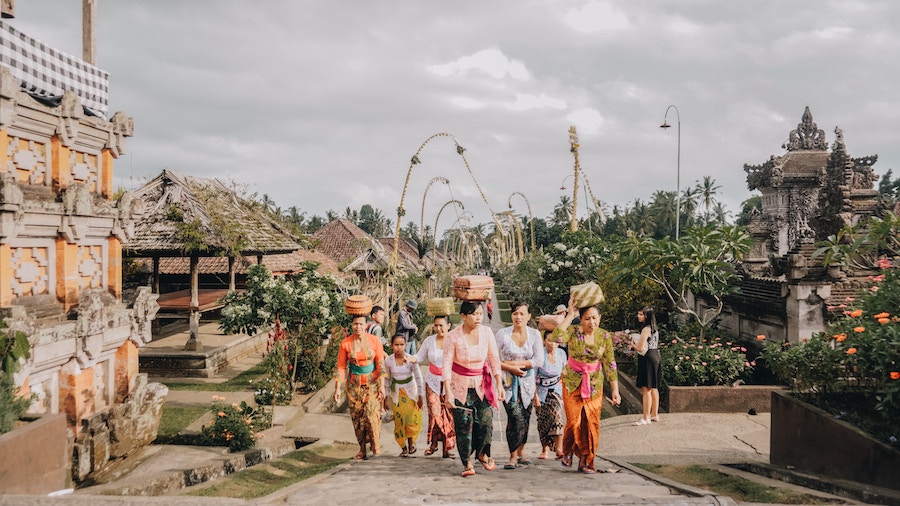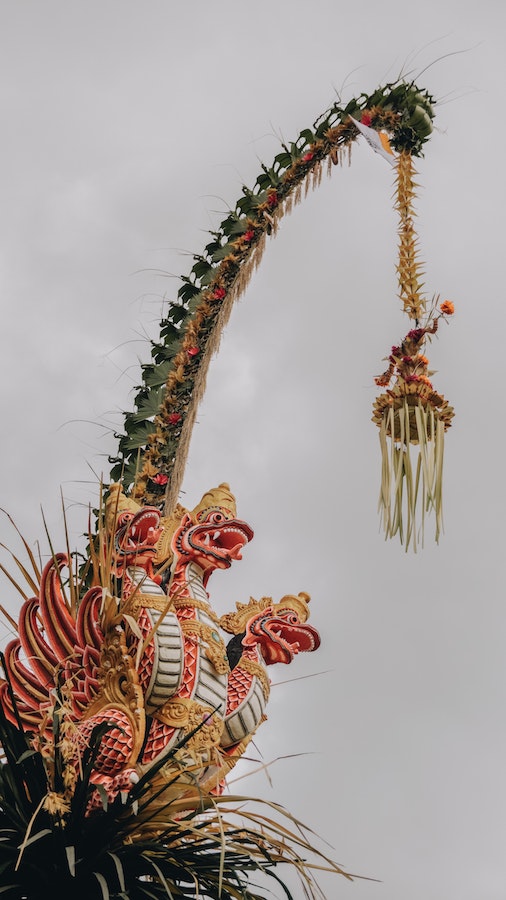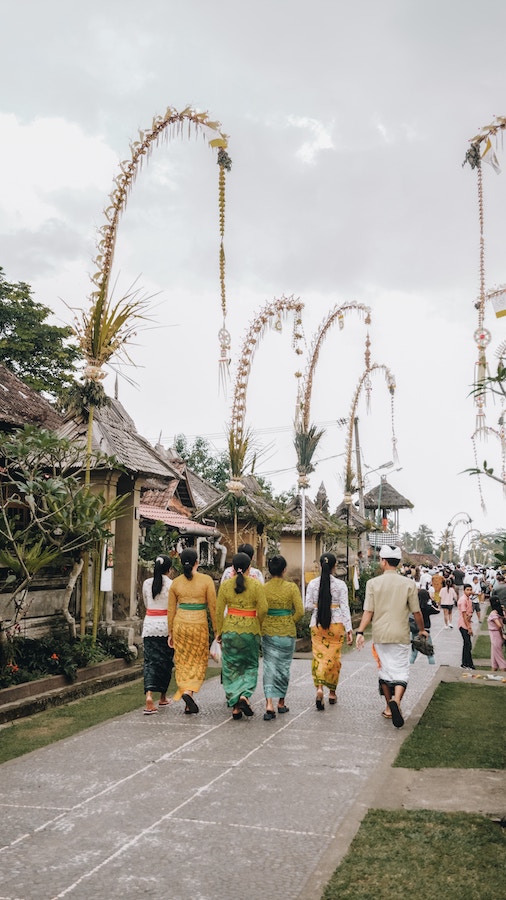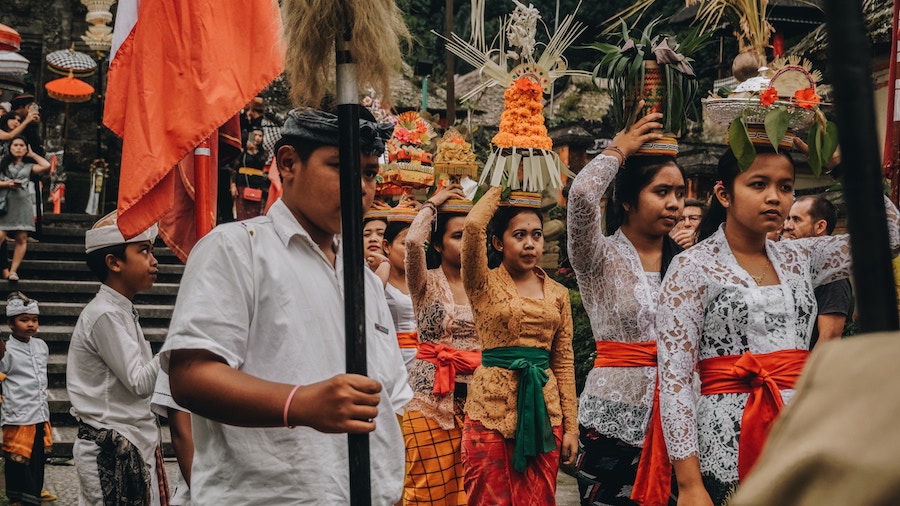
Galungan is one of the most important ceremonies on the Balinese calendar. The exact dates of this auspicious day are calculated through the 210-day Pawukon calendar, where the Galungan period will last 10 days, starting from Galungan and ending on Kuningan.
Available on your preferred Podcast Platform:
iTunes • Spotify • Google Podcasts • Pocket Casts • Radio Public
You’ll know when Galungan is coming a few days, or even weeks before it actually arrives as the whole island is bedecked in glamorous religious ornaments. Most notable are the penjor, bamboo poles decorated with offerings, that are erected on the side of the street, at the front of homes and shops.
Galungan symbolises the day that spirits, notably ancestors and deities, come down from their heavenly abode and visit Earth. To some it may resemble Mexico’s Dia de los Muertos, or day of the dead, but philosophically it is more akin to India’s Diwali as both celebrate the triumph of dharma (good) over adharma (evil).


So, what are the origins of Galungan?
As with all good Balinese ceremonies, there is a myth, or legend even, associated with it. It starts with King Mayadenawa, ruler of the Bedahulu Kingdom of the ‘Ancient Bali’ era (era Bali Kuno). He was no regular human, but was the son of King Jayapangus and Dewi Danu, Goddess of the Lake. As such he was bestowed with great power and strength.
So strong was this malevolent King that he saw himself a god, and felt that he should be worshipped as such. Mayadenawa wreaked havoc amongst the Hindu, destroying temples, denying their worship to the gods above. The Hindu people appealed to the heavens, and it was Lord Indra, the God of War, who answered.
Lord Indra descended from the heavens and began a mighty war against the tyrannical leader, Mayadenawa. Battle after battle, Indra and his army fought the beastly king in the area known today as Tampaksiring, named after Mayadenawa’s own footprints (tampak meaning foot, siring meaning slanted). The king was cunning, and with the help of his child, Patih Kalawong, they poisoned the spring from which his army drank. To cure them, Indra struck a hole into the rock beneath his feet and began a new spring, whose holy waters (tirta) healed his poisoned followers. This site is the temple we know today as Tirta Empul, the Holy Water Temple.
Finally, the power-hungry king was overcome by Lord Indra and his army. Their victory took place on the Wednesday of the 11th week of the Balinese Pawukon calendar – known today as Galungan Day, celebrated on the same cycle every 210 days. The Wednesday of the 11th week of the Pawukon calendar. this festival commemorates the this victory of Indra (dharma, or good) over King Mayadenawa (adharma, or evil).
Indra’s descent to Earth was also symbolic of other spirits descending on the same day.
So, what takes place during the Galungan festivities?

On the eve of Galungan, Penampahan Galungan, animals are sacrificed as special offerings which are meant to get rid of negativity in both the bhuana agung (the macrocosm, the world around us) and the bhuana alit (microcosm, the world within us); the meat is afterwards prepared and cooked for traditional Balinese dishes such as lawar, babi guling, and satay. The Balinese, especially the children, are looking forward to Penampahan Galungan as it is a typical family party day with lots of delicious dishes.
It is also believed that on the day of Penampahan Galungan the Sang Kala Tiga in the shape of Sang Bhuta Amangkurat descends to earth for the third and last time to tempt mankind to Adharma (evil).
Every temple and shrine and all the street corners will be busy with worshippers come Galungan Day, making it an amazing cultural showcase to witness. The atmosphere is alive: whiffs of incense in the air carry the smell of devotion even before the crack of dawn. Everybody is coming out in their traditional Balinese best to pray on this special day.
The day after Galungan, Manisan Galungan, people will visit their families, then 10 days after will be the end of the Galungan ‘season’ called Kuningan, where the spirits will return to the land ‘up there’, Tanah ane wayah.
In the Balinese calendar, Kuningan is in fact the third ‘tumpek’ ceremony of the Balinese year, which takes place on the Saturday of the 12th week of the Pakuwon cycle; it should in fact be called Tumpek Kuningan.
Why does Kuningan happen 10 days after Galungan?
Going back to the legend of Galungan (read in the Galungan story), after King Mayadenawa was defeated in battle, the victorious Balinese and Majapahit troops were worried that in fact the cunning ruler had simply conjured magic to disguise himself as a statue, a tree or animal. So, they waited for 10 days to be sure.
Upon the 10th day their victory over Mayadenawa was officially announced to the people, this was to be dubbed Kuningan Day. The word is said to have two meanings, ‘to announce’ – following the events of the legend – and yellow, which is the central colour seen throughout Kuningan worship and celebrations.
This stems from the fact that yellow rice is used as the special offerings on this day, the rice receiving its colour from the yellow root of turmeric, often used in cooking.
Yellow is also the colour of the god Wisnu, the protector of the Hindu trinity. Even worshippers will don yellow kebaya and sarongs and sashes, sticking to the theme of the day.
Prayers, offerings and family visits can be seen throughout the day. Most Kuningan celebrations take place in the privacy of the home, in the shrines of the family temple and housing compound.
Of course, the Balinese will find a way to make a spectacle out of these special days.










